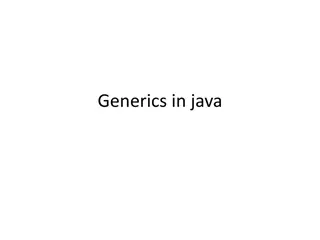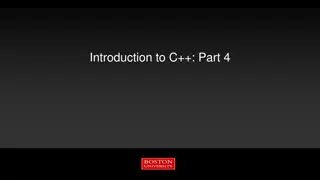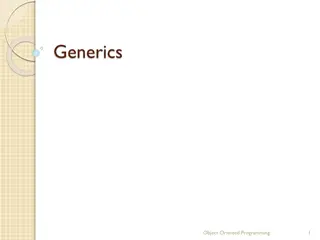Introducing Generics in C#
C# provides generics to improve type safety, reduce the need for casting, and make it easier to create generalized classes and methods. Generic classes and methods operate on specified object types. Learn how to implement generics in C# to enhance code flexibility and efficiency.
Download Presentation

Please find below an Image/Link to download the presentation.
The content on the website is provided AS IS for your information and personal use only. It may not be sold, licensed, or shared on other websites without obtaining consent from the author.If you encounter any issues during the download, it is possible that the publisher has removed the file from their server.
You are allowed to download the files provided on this website for personal or commercial use, subject to the condition that they are used lawfully. All files are the property of their respective owners.
The content on the website is provided AS IS for your information and personal use only. It may not be sold, licensed, or shared on other websites without obtaining consent from the author.
E N D
Presentation Transcript
Module-4 17. Introducing Generics Updated by: Mohan A. Gholap Original Slides by: Prof. Pushpa B. Patil 1
Prog.-1: Queue Class public int Dequeue() { if (this.numElements == 0) { throw new Exception("Queue empty"); } int queueItem = this.data[this.tail]; this.tail++; this.tail %= this.data.Length; this.numElements--; return queueItem; } } //main Queue queue = new Queue(); // Create a new Queue queue.Enqueue(100); queue.Enqueue(-25); queue.Enqueue(33); Console.WriteLine("{0}", queue.Dequeue()); // Displays 100 Console.WriteLine("{0}", queue.Dequeue()); // Displays -25 Console.WriteLine("{0}", queue.Dequeue()); // Displays 33 class Queue { private const int DEFAULTQUEUESIZE = 100; private int[] data; private int head = 0, tail = 0; private int numElements = 0; public Queue() { this.data = new int[DEFAULTQUEUESIZE]; } public Queue(int size) { if (size > 0) { this.data = new int[size]; } else { throw new ArgumentOutOfRangeException("size", "Must be greater than zero"); } } public void Enqueue(int item) { if (this.numElements == this.data.Length) { throw new Exception("Queue full"); } this.data[this.head] = item; this.head++; this.head %= this.data.Length; this.numElements++; } 2
Problem with Queue class The problem is that the way in which the Queue class is implemented restricts it to items of type int, and if you try and enqueue a Horse, you will get a compile-time error: Queue queue = new Queue(); Horse myHorse = new Horse(); queue.Enqueue(myHorse); // Compile-time error: Cannot convert from Horse to int Solution-1: using object types change the following things in the Prog-1 1. specify that the array in the Queue class contains items of type object, 2. update the constructors, and modify the Enqueue and Dequeue methods to take an object parameter. 3. return an object, class Queue { ... private object[] data; ... public Queue() { this.data = new object[DEFAULTQUEUESIZE]; } public Queue(int size) { ... this.data = new object[size]; ... } public void Enqueue(object item) { ... } public object Dequeue() { ... object queueItem =this.data[this.tail]; ... return queueItem; } } 3
Cont Problem here is 1. It requires explicit type conversion Queue queue = new Queue(); Horse myHorse = new Horse(); queue.Enqueue(myHorse); // Now legal Horse is an object... Horse dequeuedHorse =(Horse)queue.Dequeue(); // Need to cast object back to a Horse If you don t cast the returned value, you will get the compiler error Cannot implicitly convert type object to Horse. Queue queue = new Queue(); Horse myHorse = new Horse();queue.Enqueue(myHorse); 2. The two types are not compatible Example Circle myCircle = (Circle)queue.Dequeue(); // run-time error 3. It consumes additional memory and processor time if the runtime needs to convert an object to a value type and back again. Queue queue = new Queue(); int myInt = 99; queue.Enqueue(myInt); // box the int to an object.. myInt = (int)queue.Dequeue(); // unbox the object to an int 4
The Generics Solution C# provides generics to remove the need for casting, improve type safety, reduce the amount of boxing required, and make it easier to create generalized classes and methods. Generic classes and methods accept type parameters, which specify the types of objects that they operate on. In C#, you indicate that a class is a generic class by providing a type parameter in angle brackets, like this: class Queue<T> { ...} The T in this example acts as a placeholder for a real type at compile time. When you write code to instantiate a generic Queue, you provide the type that should be substituted for T (Circle, Horse, int, and so on). When you define the fields and methods in the class, you use this same placeholder to indicate the type of these items, class Queue<T> { ... private T[] data; // array is of type 'T' where 'T' is the type parameter ... public Queue() { this.data = new T[DEFAULTQUEUESIZE]; // use 'T' as the data type } public Queue(int size) { ... this.data = new T[size]; ... } public void Enqueue(T item) // use 'T' as the type of the method parameter { ... } public T Dequeue() // use 'T' as the type of the return value { ... T queueItem = this.data[this.tail]; // the data in the array is of type 'T' ... return queueItem; } } 5
Creating a Generic Method You can specify the types of the parameters and the return type by using a type parameter. You can define generalized methods that are type-safe and avoid the overhead of casting (and boxing, in some cases). Generic methods are frequently used in conjunction with generic classes static void Swap<T>(ref T first, ref T second) { T temp = first; first = second; second = temp; } The following examples show how to invoke the Swap<T> method to swap over two ints and two strings: //Main int a = 1, b = 2; Swap<int>(ref a, ref b); string s1 = "Hello", s2 = "World"; Swap<string>(ref s1, ref s2); 6
Generics vs. Generalized Classes or Differation between generics and generalized classes Generics classes Generic class that uses type parameters Example Queue<T> class. Each time you use this class with a type parameter (such as Queue<int> or Queue<Horse>), you cause the compiler to generate an entirely new class that happens to have functionality defined by the generic class This means that Queue<int> is a completely different type from Queue<Horse>, but they both happen to have the same behavior Generalized classes These are designed to take parameters that can be cast to different types For example, the object-based version of the Queue class shown earlier is a generalized class There is a single implementation of this class, and its methods take object parameters and return object types 7
Creating a Generic Class The Theory of Binary Trees 8
Module 4 18. Using Collections Why we need collections ? Arrays provide only limited functionality; It is not easy to increase or reduce the size of an array Arrays only really provide a single means of accessing data, by using an integer index. If your application needs to store and retrieve data by using some other mechanism, such as the first-in, first-out queue mechanism then arrays may not be the most suitable data structure to use 9
What Are Collection Classes? The Microsoft .NET Framework provides several classes that collect elements together and enable an application to access them in specialized ways. These collection classes live in the System.Collections.Generic namespace. 10
Most commonly used collection classes Description Collection 1.List<T> A list of objects that can be accessed by index, like an array, but with additional methods to search the list and sort the contents of the list. 2. Queue<T> A first-in, first-out data structure, with methods to add an item to one end of the queue, remove an item from the other end, and examine an item without removing it. 3. Stack<T> A first-in, last-out data structure with methods to push an item onto the top of the stack, pop an item from the top of the stack, and examine the item at the top of the stack without removing it. 4. LinkedList<T> A double-ended ordered list, optimized to support insertion and removal at either end. This collection can act like a queue or a stack, but it also supports random access like a list. 5.HashSet<T> An unordered set of values that is optimized for fast retrieval of data. It provides set-oriented methods for determining whether the items it holds are a subset of those in another HashSet<T> object, as well as computing the intersection and union of HashSet<T> objects. 6.Dictionary<TKey, TValue> A collection of values that can be identified and retrieved by using keys rather than indexes. 7.SortedList<TKey, TValue> A sorted list of key/value pairs. The keys must implement the 11
1. The List<T> Collection Class The generic List<T> class is the simplest of the collection classes. You can use it much like an array you can reference an existing element in a List<T> collection by using ordinary array notation, with square brackets and the index of the element, although you cannot use array notation to add new elements. However, in general, the List<T> class provides more flexibility than arrays Designed to overcome the following restrictions exhibited by arrays: 1. If you want to resize an array, you have to create a new array, copy the elements (leaving out some if the new array is smaller), and then update any references to the original array so that they refer to the new array. 2. If you want to remove an element from an array, you have to move all the trailing elements up by one place. Even this doesn t quite work, because you end up with two copies of the last element. 3. If you want to insert an element into an array, you have to move elements down by one place to make a free slot. However, you lose the last element of the array! The List<T> collection class provides the following features that remove these limitations: 1. You don t need to specify the capacity of a List<T> collection when you create it; it can grow and shrink as you add elements. There is an overhead associated with this dynamic behavior, and if necessary you can specify an initial size. However, if you exceed this size, then the List<T> collection will simply grow as necessary. 2. You can remove a specified element from a List<T> collection by using the Remove method. The List<T> collection automatically reorders its elements and closes the gap. You can also remove an item at a specified position in a List<T> collection by using the RemoveAt method. 3. You can add an element to the end of a List<T> collection by using its Add method. 4. You can insert an element into the middle of a List<T> collection by using the Insert method. Again, the List<T> collection resizes itself. 5. You can easily sort the data in a List<T> object by calling the Sort method 12
Programming example for List using System; using System.Collections.Generic; using System.Text; namespace Listexample { class Program { static void Main(string[] args) { List<int> numbers = new List<int>(); foreach (int number in new int[12]{10, 9, 8, 7, 7, 6, 5, 10, 4, 3, 2, 1}) { numbers.Add(number); } // The first parameter is the position; the second parameter is the value being inserted numbers.Insert(numbers.Count-1, 99); // Remove first element whose value is 7 (the 4th element, index 3) numbers.Remove(7); // Remove the element that's now the 7th element, index 6 (10) numbers.RemoveAt(6); // Iterate remaining 11 elements using a for statement Console.WriteLine("Iterating using a for statement:"); for (int i = 0; i < numbers.Count; i++) { int number = numbers[i]; // Note the use of array syntax Console.WriteLine(number); } // Iterate the same 11 elements using a foreach statement Console.WriteLine("\nIterating using a foreach statement:"); foreach (int number in numbers) { Console.WriteLine(number); } Console.Read(); } 13
2. The LinkedList<T> Collection Class It implements the doubly linked list Each node(item) in the holds reference to Next item, reference to Previous item, and value Functions To add the nodes to list 1. AddFirst 2. AddLast 3. AddBefore 4. AddAfter Functions To delete the nodes from list 1. RemoveFirst 2. ReoveAt 3. RemoveLast 14
Programming Example for LinkedList class using System; using System.Collections.Generic;. Class mainclass { LinkedList<int> numbers = new LinkedList<int>(); // Fill the List<int> by using the AddFirst method foreach (int number in new int[] { 10, 8, 6, 4, 2 }) { numbers.AddFirst(number);} // Iterate using a for statement Console.WriteLine("Iterating using a for statement:"); for (LinkedListNode<int> node = numbers.First; node != null; node = node.Next) { int number = node.Value; Console.WriteLine(number);} // Iterate using a foreach statement Console.WriteLine("\nIterating using a foreach statement:"); foreach (int number in numbers) { Console.WriteLine(number);} // Iterate backwards Console.WriteLine("\nIterating list in reverse order:"); for (LinkedListNode<int> node = numbers.Last; node != null; node = node.Previous) { int number = node.Value; Console.WriteLine(number);} } 15
3. The Queue<T> Collection Class The Queue<T> class implements a first-in, first-out mechanism. An element is inserted into the queue at the back (the Enqueue operation) and is removed from the queue at the front (the Dequeue operation). Programming Example: using System; using System.Collections.Generic; Class mainclass { Public static void Main() { Queue<int> numbers = new Queue<int>(); // fill the queue Console.WriteLine("Populating the queue:"); foreach (int number in new int[4]{9, 3, 7, 2}) { numbers.Enqueue(number); Console.WriteLine("{0} has joined the queue", number);} // iterate through the queue Console.WriteLine("\nThe queue contains the following items:"); foreach (int number in numbers) { Console.WriteLine(number);} // empty the queue Console.WriteLine("\nDraining the queue:"); while (numbers.Count > 0) { int number = numbers.Dequeue(); Console.WriteLine("{0} has left the queue", number); } } } 16
4. The Stack<T> Collection Class using System; using System.Collections.Generic; Class mainapp { public static void Main() { Stack<int> numbers = new Stack<int>(); Console.WriteLine("Pushing items onto the stack:"); foreach (int number in new int[4]{9, 3, 7, 2}) { numbers.Push(number); Console.WriteLine("{0} has been pushed on the stack", number); } Console.WriteLine("\nThe stack now contains:"); // iterate through the stack foreach (int number in numbers) { Console.WriteLine(number); } Console.WriteLine("\nPopping items from the stack:"); // empty the stack while (numbers.Count > 0) { int number = numbers.Pop(); Console.WriteLine("{0} has been popped off the stack", number); } } } 17
5. The Dictionary<TKey, TValue> Collection Class Dictionary<TKey, TValue> collection allow us to map not only an int but rather some other types, such as string, double, or Time A Dictionary<TKey, TValue> collection cannot contain duplicate keys. If you call the Add method to add a key that is already present in the keys array, you ll get an exception. You can, however, use the square brackets notation to add a key/value pair (as shown in the following example), without danger of an exception, even if the key has already been added; any existing value with the same key will be overwritten by the new value. You can test whether a Dictionary<TKey, TValue> collection already contains a particular key by using the ContainsKey method. Internally, a Dictionary<TKey, TValue> collection is a sparse data structure that operates most efficiently when it has plenty of memory to work in. The size of a Dictionary<TKey, TValue> collection in memory can grow quite quickly as you insert more elements. When you use a foreach statement to iterate through a Dictionary<TKey, TValue> collection, you get back a KeyValuePair<TKey, TValue> item. This is a structure that contains a copy of the key and value elements of an item in the Dictionary<TKey, TValue> collection, and you can access each element through the Key property and the Value properties. These elements are read-only;. 18
5. The Dictionary<TKey, TValue> Collection Class(Con t ) Prog-5 using System.Collections.Generic; Class mainApp{ public static void Main() {Dictionary<string, int> ages = new Dictionary<string, int>(); // fill the Dictionary ages.Add("John", 47); // using the Add method ages.Add("Diana", 46); ages["James"] = 20; // using array notation ages["Francesca"] = 18; // iterate using a foreach statement// the iterator generates a KeyValuePair item Console.WriteLine("The Dictionary contains:"); foreach (KeyValuePair<string, int> element in ages) { string name = element.Key; int age = element.Value; Console.WriteLine("Name: {0}, Age: {1}", name, age); }}} The output of program: The Dictionary contains Name: John, Age: 47 Name: Diana, Age: 46 Name: James, Age: 20 Name: Francesca, Age: 18 19
6. The SortedList<TKey, TValue> Collection Class The SortedList<TKey, TValue> class is very similar to the Dictionary<TKey, TValue> class. The main difference is that the keys array is always sorted. When you insert a key/value pair into a SortedList<TKey, TValue> collection, the key is inserted into the keys array at the correct index to keep the keys array sorted. The value is then inserted into the values array at the same index. They are always sorted based on the value of the keys. Like the Dictionary<TKey, TValue> class, a SortedList<TKey, TValue> collection cannot contain duplicate keys Programming Example: In prog-5, replace the word Dictionary by SortedList The output of program: The Dictionary contains Name: Diana, Age: 46 Name: Francesca, Age: 18 Name: James, Age: 20 Name :John, Age: 47 20
7. The HashSet<T> Collection Class The HashSet<T> class is optimized for performing set operations, such as determining set membership and generating the union and intersect of sets. You can also determine whether the data in one HashSet<T> collection is a superset or subset of another by using the IsSubsetOf, IsSupersetOf, IsProperSubsetOf, and IsProperSupersetOf methods. These methods return a Boolean value. Programming example using System; using System.Collections.Generic; Class mainapp { Public static void Main() { HashSet<string> employees = new HashSet<string>(new string[] {"Fred","Bert","Harry","John"}); HashSet<string> customers = new HashSet<string>(new string[] {"John","Sid","Harry","Diana"}); employees.Add("James"); customers.Add("Francesca") Console.WriteLine("Employees:"); foreach (string name in employees) { Console.WriteLine(name);} Console.WriteLine("\nCustomers:"); foreach (string name in customers) { Console.WriteLine(name);} Console.WriteLine("\nCustomers who are also employees:"); customers.IntersectWith(employees); foreach (string name in customers) { Console.WriteLine(name);} } } Output: Employees: FredBert Harry John James Customers: John Sid Harry Diana Francesca Customers who are also employees: John Harry 21























